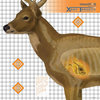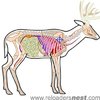Doc7
Member
i am on my phone all week on vacation so will have to not post a photo on this thread.
There's a ton of differing vocabulary in hunting which leads to quite the confusion. Case in point, where I work, I can argue till I am red in the face and still nobody will agree with me that walking slowly through the woods, pausing to look and listen for wild game, is called "Still Hunting." To a man, despite Field&Stream and the collective population of the internet on my side, "Still Hunting" to my coworkers means sitting in a tree stand or ground blind.
The particular piece of deer anatomy I find to be very confusing to people is the reference to the "Shoulder".
Some people like to shoot deer "in the shoulder" for a DRT bang-flop. Others shoot "right behind the shoulder" for heart and lungs. I think the people who are saying "right behind the shoulder" are referring to the deers armpit, because otherwise right behind the shoulder would be well above the traditional target heart and lung area.
Others take to calling the shoulder shot the "high shoulder shot", which certainly removes ambiguity for their aiming point and if they were telling a novice where to shoot while staring at a buck from the tree stand. But I haven't heard anyone refer to heart lung as being "a few inches behind the low shoulder".
What is correct way to refer to the heart lung spot?
There's a ton of differing vocabulary in hunting which leads to quite the confusion. Case in point, where I work, I can argue till I am red in the face and still nobody will agree with me that walking slowly through the woods, pausing to look and listen for wild game, is called "Still Hunting." To a man, despite Field&Stream and the collective population of the internet on my side, "Still Hunting" to my coworkers means sitting in a tree stand or ground blind.
The particular piece of deer anatomy I find to be very confusing to people is the reference to the "Shoulder".
Some people like to shoot deer "in the shoulder" for a DRT bang-flop. Others shoot "right behind the shoulder" for heart and lungs. I think the people who are saying "right behind the shoulder" are referring to the deers armpit, because otherwise right behind the shoulder would be well above the traditional target heart and lung area.
Others take to calling the shoulder shot the "high shoulder shot", which certainly removes ambiguity for their aiming point and if they were telling a novice where to shoot while staring at a buck from the tree stand. But I haven't heard anyone refer to heart lung as being "a few inches behind the low shoulder".
What is correct way to refer to the heart lung spot?





